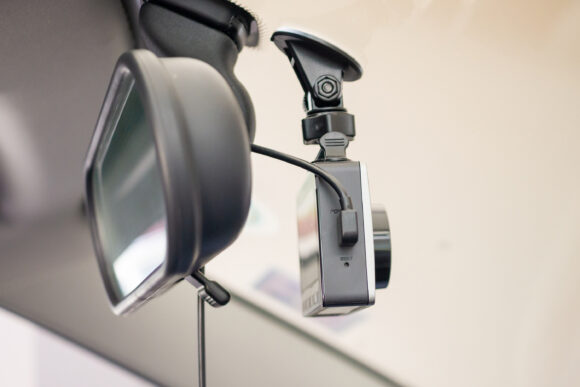ORLANDO, Fla. — Cameras. One showing the driver and another facing forward.
Those can be the keys to avoiding nuclear verdicts after auto and truck crashes, especially for companies with fleets of vehicles and relatively inexperienced drivers, two Crum & Forster risk executives said Monday at the International Risk Management Institute’s Annual Construction Risk Conference.
“Fleet liability has not been profitable for insurers for a long time,” said Paul Anderson, vice president of field underwriting for the national group of property/casualty insurance companies.

That means that premiums continue to rise, forcing insurers and insured companies to take steps to reduce losses, prevent accidents, prove fault – and to minimize the cost of jury trials that can end up in multi-million awards for motorists injured or killed by a company vehicle.
The number of so-called nuclear verdicts, of $1 million or more, has increased 967% in the United States in the last 13 years against firms with truck fleets, according to data from the American Transportation Research Institute. The average verdict has climbed from $5 million to more than $20 million, Louise Vallee, Crum & Forster’s vice president for risk engineering, said at a session at the IRMI conference.
The size of jury verdicts has grown so much, in fact, that the industry has come up with a new term: Thermonuclear verdicts, for awards of $10 million or more, Anderson noted.
The reasons for the larger verdicts are many, but Anderson and Vallee said that plaintiffs’ attorneys have developed new litigation strategies that delve deeply into companies’ driver safety and training programs, their drug-screening policies and background checks of employees, along with their monitoring of drivers’ behaviors behind the wheel.
Why are Accident Reconstruction Experts Always Looking for Dash Camera Videos?
Viewpoint: Accident Reconstruction in Insurance Fraud Investigations
Litigation funding is one reason for some plaintiffs’ lawyers’ more-aggressive tactics, but most juries are not told that the investors often get their share of an award first, even before attorney fees are carved out.
“There needs to be more transparency on that,” Vallee noted.
The good news, she said, is that risk improvement is possible, even in the accident and injury-prone commercial construction world. After years in risk management, Vallee and Anderson have devised a best-practices checklist for firms that operate vehicles:
Place cameras in all company vehicles, one on the dashboard showing the driver’s face and one aiming forward. Then connect the cams to software that sends an alert to the company office when a driver appears distracted, sleepy or is texting on his or her cell phone. Distracted driving continues to be a major factor behind crashes, nationwide.

At the least, the camera video will let the business and its insurer see if the company driver is actually at fault, which can lead to early settlement efforts before a case goes to trial. At the most, the cameras may show what really happened and that the employee was not at fault. Cameras can also prosecute fraud and expose staged accidents done by other drivers.
Many corporations with fleets already utilize non-camera telematics systems that track drivers’ actions. But these tend to send too many alerts, so that the home office is overwhelmed and doesn’t pay attention; or, the data is not checked until days later, Anderson explained. One actuarial study found no difference in loss ratios for companies that utilized telematics without vehicle cameras, Anderson said.
Perform drug tests and extensive background checks on employees that may operate vehicles, even those whose main job is not driving. Plaintiffs’ attorneys will hone in a company’s policies and procedures in this area, Vallee said.
“Don’t try to save a few bucks by avoiding drug screenings,” she said.
Beef up training of drivers. Many workers who drive trucks have other duties and may not be focused on the subleties of handling heavy vehicles. But massive rigs such as dump trucks and concrete-mixing trucks require special handling and extra braking distances. On a noisy, congested job site, drivers should also find spotters to help avoid accidents when backing up or loading and unloading. Make sure employees are well-trained and that all training is documented.
Develop scorecards for workers. Data from cameras and tracking systems can produce scores for drivers. Paired with incentives, scorecards can produce friendly competition among employees.
Know thy public records. Vehicle inspection records are publicly available in many states. Ensure that fleet vehicles are well-maintained and inspected properly – and know what the public records indicate.
Avoid website banners proclaiming “Safety is our No. 1 priority,” Vallee said. “That’s fresh meat for plaintiffs attorneys” who may attempt to show that a construction firm did not live up to its own hype.
If insureds feel they cannot afford to implement such extensive policy changes, they should check with their insurance company, Vallee said. Assistance may be available. Crum & Forster, for example offers a program that analyzes company practices and can result in significant premium discounts, Vallee said.
“There is hope,” she said, noting that more and more businesses with vehicles fleets are installing cameras and taking other steps that make a difference.
Was this article valuable?
Here are more articles you may enjoy.


 Musk’s X Probed by UK Over Grok’s Thousands of Sexualized Images
Musk’s X Probed by UK Over Grok’s Thousands of Sexualized Images  Munich Re: Insured Losses From Wildfires, Storms and Floods Hit Record High
Munich Re: Insured Losses From Wildfires, Storms and Floods Hit Record High  The Return Period for An LA Wildfire-Scale Event May Be Shorter Than You Think
The Return Period for An LA Wildfire-Scale Event May Be Shorter Than You Think  Cyber Breach Affected 750,000 Canadian Investors, Regulator Says
Cyber Breach Affected 750,000 Canadian Investors, Regulator Says 